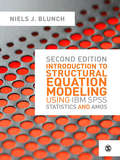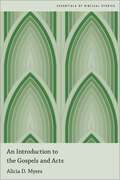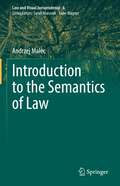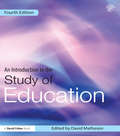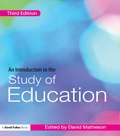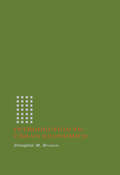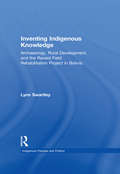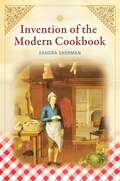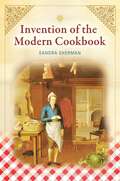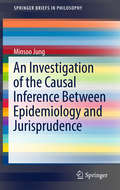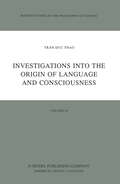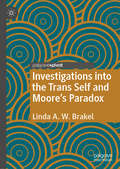- Table View
- List View
Introduction to Structural Equation Modeling Using IBM SPSS Statistics and Amos
by Niels J. BlunchThis comprehensive Second Edition offers readers a complete guide to carrying out research projects involving structural equation modeling (SEM). Updated to include extensive analysis of AMOS' graphical interface, a new chapter on latent curve models and detailed explanations of the structural equation modeling process, this second edition is the ideal guide for those new to the field. The book includes: Learning objectives, key concepts and questions for further discussion in each chapter. Helpful diagrams and screenshots to expand on concepts covered in the texts. Real life examples from a variety of disciplines to show how SEM is applied in real research contexts. Exercises for each chapter on an accompanying companion website. A new glossary. Assuming no previous experience of the subject, and a minimum of mathematical knowledge, this is the ideal guide for those new to SEM and an invaluable companion for students taking introductory SEM courses in any discipline. Niels J. Blunch was formerly in the Department of Marketing and Statistics at the University of Aarhus, Denmark
An Introduction to the Early Development of Mathematics
by Michael K. GoodmanAn easy-to-read presentation of the early history of mathematics Engaging and accessible, An Introduction to the Early Development of Mathematics provides a captivating introduction to the history of ancient mathematics in early civilizations for a nontechnical audience. Written with practical applications in a variety of areas, the book utilizes the historical context of mathematics as a pedagogical tool to assist readers working through mathematical and historical topics. The book is divided into sections on significant early civilizations including Egypt, Babylonia, China, Greece, India, and the Islamic world. Beginning each chapter with a general historical overview of the civilized area, the author highlights the civilization’s mathematical techniques, number representations, accomplishments, challenges, and contributions to the mathematical world. Thoroughly class-tested, An Introduction to the Early Development of Mathematics features: Challenging exercises that lead readers to a deeper understanding of mathematics Numerous relevant examples and problem sets with detailed explanations of the processes and solutions at the end of each chapter Additional references on specific topics and keywords from history, archeology, religion, culture, and mathematics Examples of practical applications with step-by-step explanations of the mathematical concepts and equations through the lens of early mathematical problems A companion website that includes additional exercises An Introduction to the Early Development of Mathematics is an ideal textbook for undergraduate courses on the history of mathematics and a supplement for elementary and secondary education majors. The book is also an appropriate reference for professional and trade audiences interested in the history of mathematics. Michael K. J. Goodman is Adjunct Mathematics Instructor at Westchester Community College, where he teaches courses in the history of mathematics, contemporary mathematics, and algebra. He is also the owner and operator of The Learning Miracle, LLC, which provides academic tutoring and test preparation for both college and high school students.
An Introduction to the Early Development of Mathematics
by Michael K. GoodmanAn easy-to-read presentation of the early history of mathematics Engaging and accessible, An Introduction to the Early Development of Mathematics provides a captivating introduction to the history of ancient mathematics in early civilizations for a nontechnical audience. Written with practical applications in a variety of areas, the book utilizes the historical context of mathematics as a pedagogical tool to assist readers working through mathematical and historical topics. The book is divided into sections on significant early civilizations including Egypt, Babylonia, China, Greece, India, and the Islamic world. Beginning each chapter with a general historical overview of the civilized area, the author highlights the civilization’s mathematical techniques, number representations, accomplishments, challenges, and contributions to the mathematical world. Thoroughly class-tested, An Introduction to the Early Development of Mathematics features: Challenging exercises that lead readers to a deeper understanding of mathematics Numerous relevant examples and problem sets with detailed explanations of the processes and solutions at the end of each chapter Additional references on specific topics and keywords from history, archeology, religion, culture, and mathematics Examples of practical applications with step-by-step explanations of the mathematical concepts and equations through the lens of early mathematical problems A companion website that includes additional exercises An Introduction to the Early Development of Mathematics is an ideal textbook for undergraduate courses on the history of mathematics and a supplement for elementary and secondary education majors. The book is also an appropriate reference for professional and trade audiences interested in the history of mathematics. Michael K. J. Goodman is Adjunct Mathematics Instructor at Westchester Community College, where he teaches courses in the history of mathematics, contemporary mathematics, and algebra. He is also the owner and operator of The Learning Miracle, LLC, which provides academic tutoring and test preparation for both college and high school students.
An Introduction to the Gospels and Acts (Essentials of Biblical Studies)
by Alicia D. MyersIntroducing the Gospels and Acts is not just about reading the first five books of the New Testament. It requires entering the first century Mediterranean world where the events in these writings happened. In this short book, Alicia D. Myers takes readers on a journey through the Gospels and Acts, introducing them to the world of Jesus of Nazareth and of the believers who composed and shared stories inspired by him. Myers provides overviews of context and major passages in each canonical work, and also introduces readers to the Apocryphal Gospels and Acts to demonstrate the larger phenomenon of early Christian writing. After situating readers in the literary context of the Gospels and Acts, Myers focuses on the writings themselves, giving basic historical background before digging more deeply into a chosen contextual theme for each work. These six themes include the politics and history of Roman Palestine, expressions of Second Temple Judaism, understandings of identity and human worth in the Roman world, hospitality, Hellenistic philosophies, and the process of canonizing the New Testament. Rather than shying away from difficult and often confusing elements of the Gospels and Acts, Myers invites readers to engage more deeply and situate themselves more fully in the strangeness and surprising familiarity of the Roman world. In this way, readers will see the continuing relevance of the Gospels and Acts for today and learn to be responsible readers of these works for years to come.
An Introduction to the Gospels and Acts (Essentials of Biblical Studies)
by Alicia D. MyersIntroducing the Gospels and Acts is not just about reading the first five books of the New Testament. It requires entering the first century Mediterranean world where the events in these writings happened. In this short book, Alicia D. Myers takes readers on a journey through the Gospels and Acts, introducing them to the world of Jesus of Nazareth and of the believers who composed and shared stories inspired by him. Myers provides overviews of context and major passages in each canonical work, and also introduces readers to the Apocryphal Gospels and Acts to demonstrate the larger phenomenon of early Christian writing. After situating readers in the literary context of the Gospels and Acts, Myers focuses on the writings themselves, giving basic historical background before digging more deeply into a chosen contextual theme for each work. These six themes include the politics and history of Roman Palestine, expressions of Second Temple Judaism, understandings of identity and human worth in the Roman world, hospitality, Hellenistic philosophies, and the process of canonizing the New Testament. Rather than shying away from difficult and often confusing elements of the Gospels and Acts, Myers invites readers to engage more deeply and situate themselves more fully in the strangeness and surprising familiarity of the Roman world. In this way, readers will see the continuing relevance of the Gospels and Acts for today and learn to be responsible readers of these works for years to come.
Introduction to the Semantics of Law (Law and Visual Jurisprudence #6)
by Andrzej MalecThis book offers an introduction to the language of law from the perspective of logical semantics. As a logical tool, Boguslaw Wolniewicz’s formal ontology of situations is adapted. The central issue addressed is the meaning of normative statements, primarily legal norms. The main outcome of the book consists in explications of several legal notions (including legal events, legal acts and legal rules) in terms of the formal ontology of situations. In addition, the book concludes that legal norms are sentences in a logical sense, so some are true, while others are false, and that their logical value does not depend on whether or not they were adopted in the law-making process. Lastly, the book contends that there are semantic relations between orders that are similar to entailment, contradiction, opposition, and sub-opposition, despite the fact that orders are not sentences in a logical sense, i.e., they are neither true nor false.The book also presents some original Wittgenstein-style deontic logics built on the first order logic. The formal results are applied to selected problems in the theory of law, including the problem of the possibility of algorithmic application of legal norms.
An Introduction to the Study of Education
by David MathesonThis fully updated, fourth edition of An Introduction to the Study of Education provides a comprehensive and reflective introduction to the study of education, inviting students to question what education is, who it is for and what purpose it serves. Taking the reader from the early years through to lifelong learning, it examines all forms of education and learning. This new edition includes ten completely new chapters and a step-by-step guide to essay writing. There is also a companion website to accompany the book, featuring additional chapters which can be visited at www.routledge.com/cw/matheson.This fully updated, fourth edition provides: a full exploration of the historical, sociological, philosophical and psychological roots of education; a clear focus on the individual levels of education – preschool, compulsory, post-compulsory and lifelong learning; the latest debates within special educational needs; an in-depth examination of learning styles; insights into the historical development of education and the role of, and background to, research in education; a focus on current educational practice and diversity across the United Kingdom and Ireland. Written in a clear and accessible style, this is the essential core text for all beginning students on undergraduate and postgraduate courses in Education Studies and all those interested in education today, where it came from and where it is going.
An Introduction to the Study of Education
by David MathesonThis fully updated, fourth edition of An Introduction to the Study of Education provides a comprehensive and reflective introduction to the study of education, inviting students to question what education is, who it is for and what purpose it serves. Taking the reader from the early years through to lifelong learning, it examines all forms of education and learning. This new edition includes ten completely new chapters and a step-by-step guide to essay writing. There is also a companion website to accompany the book, featuring additional chapters which can be visited at www.routledge.com/cw/matheson.This fully updated, fourth edition provides: a full exploration of the historical, sociological, philosophical and psychological roots of education; a clear focus on the individual levels of education – preschool, compulsory, post-compulsory and lifelong learning; the latest debates within special educational needs; an in-depth examination of learning styles; insights into the historical development of education and the role of, and background to, research in education; a focus on current educational practice and diversity across the United Kingdom and Ireland. Written in a clear and accessible style, this is the essential core text for all beginning students on undergraduate and postgraduate courses in Education Studies and all those interested in education today, where it came from and where it is going.
An Introduction to the Study of Education
by David MathesonWhat is education? This core textbook will help students in pursuit of this question by providing a comprehensive, gentle and reflective introduction to the initial study of education. Updated in line with the latest policies, reforms and issues within education, this third edition includes: full exploration of the historical, sociological, philosophical and psychological roots of education a focus on all levels of education – pre-school, primary, secondary, post-16 and lifelong learning the latest controversies and debates within education new material on compulsory education, special educational needs and post-16 developments clear insights into the role and background of research within education.
An Introduction to the Study of Education
by David MathesonWhat is education? This core textbook will help students in pursuit of this question by providing a comprehensive, gentle and reflective introduction to the initial study of education. Updated in line with the latest policies, reforms and issues within education, this third edition includes: full exploration of the historical, sociological, philosophical and psychological roots of education a focus on all levels of education – pre-school, primary, secondary, post-16 and lifelong learning the latest controversies and debates within education new material on compulsory education, special educational needs and post-16 developments clear insights into the role and background of research within education.
Introduction to Urban Economics
by Douglas M. BrownIntroduction to Urban Economics offers a complete and self-contained coverage of urban economics. This book analyzes the economic rationale and growth and development of cities, theory and empirical analysis of urban markets, and problems and policies of urban economies. This text is divided into inter- and intra-urban analysis. Discussions on inter-urban analysis comprise Chapters 1 to 3 that include an introduction to urban economics, economic history of urban areas, and economics of urban growth. The rest of the chapters that cover intra-urban analysis describe the theories of urban markets, empirical tests of the theories, and implications of the empirical findings for policy decisions. This publication is valuable to students with a background in economic principles.
Introductory Economics
by Michael VesethIntroductory Economics deals with the national economy as a whole—macroeconomics, in terms of inflation and unemployment. The book also discusses individual economic decision-makers—microeconomics, in view of the problems of scarcity and choice. Macroeconomics uses the market model of demand and supply as a tool to analyze the causes of, and present some cures for modern economic ailments. The text examines the economics of government fiscal policies with the framework of an aggregate demand and supply model. The book compares monetary policy and fiscal policy, explains the monetarist model of economic activity, and also investigates the roles of money, credit, interest rates. These economic activities have international consequences such as in trade, exchange rates, and on prevailing and future national economic policies. In microeconomics, the book focuses on the economics of exchange, the market mechanisms that increase the gains from trade, and the problems of choice facing consumers and producers in a competitive market. The text also tackles the problems found in resource markets (labor, natural resources, energy), in market failure, as well as analyzes the role of government. Economists, sociologists, students of economics or business, general readers interested in real-world economics, and policy makers involved in national economic development will find the book valuable.
Introductory Microeconomics
by Michael VesethIntroductory Microeconomics explains the basic principles of microeconomics, producer and consumer choices, resource markets, and government policies. The book describes the economics of exchange, such as the role of economic growth, factors that determine the amount and types of exchange, the supply and demand model of market operations, price setting, price changes, and the impact of one market on other markets. The text also explains market failures in terms of free market choice, externalities of failures, monopolies, as well as scarcity and choices leading to poverty. When economic policies are considered by the state, there are trade-offs that are necessary in the exchange. Before the government should make decisions, it always has to consider two opportunity costs, namely, 1) budget constraints, and 2) the opportunity cost of the funds spent in the private sector. For example (no. 1), if more money is spent on transfer payments, less will be left for education, national defense, infrastructure. Another example (no. 2) is when the government collects taxes, a direct loss in real income and utility among consumers will result. The book also presents real world economics in terms of the social security tax in the United States. The book can prove valuable for students of economics or business, sociologists, general readers interested in real-world economics, and policy makers involved in national economic development.
Inventing a Space Mission: The Story of the Herschel Space Observatory (ISSI Scientific Report Series #14)
by Vincent Minier Roger-Maurice Bonnet Vincent Bontems Thijs De Graauw Matt Griffin Frank Helmich Göran Pilbratt Sergio VolonteThis book describes prominent technological achievements within a very successful space science mission: the Herschel space observatory. Focusing on the various processes of innovation it offers an analysis and discussion of the social, technological and scientific context of the mission that paved the way to its development. It addresses the key question raised by these processes in our modern society, i.e.: how knowledge management of innovation set the conditions for inventing the future? In that respect the book is based on a transdisciplinary analysis of the programmatic complexity of Herschel, with inputs from space scientists, managers, philosophers, and engineers. This book is addressed to decision makers, not only in space science, but also in other industries and sciences using or building large machines. It is also addressed to space engineers and scientists as well as students in science and management.
Inventing Indigenous Knowledge: Archaeology, Rural Development and the Raised Field Rehabilitation Project in Bolivia (Indigenous Peoples and Politics)
by Lynn SwartleyThis volume provides a multi-sited and multivocalic investigation of the dynamic social, political and economic processes in the creation and implementation of an agricultural development project. The raised field rehabilitation project attempted to introduce a pre-Columbian agricultural method into the contemporary Lake Titicaca Basin.
Inventing Indigenous Knowledge: Archaeology, Rural Development and the Raised Field Rehabilitation Project in Bolivia (Indigenous Peoples and Politics)
by Lynn SwartleyThis volume provides a multi-sited and multivocalic investigation of the dynamic social, political and economic processes in the creation and implementation of an agricultural development project. The raised field rehabilitation project attempted to introduce a pre-Columbian agricultural method into the contemporary Lake Titicaca Basin.
Invention of the Modern Cookbook
by Sandra ShermanThis eye-opening history will change the way you read a cookbook or regard a TV chef, making cooking ventures vastly more interesting—and a lot more fun.Every kitchen has at least one well-worn cookbook, but just how did they come to be? Invention of the Modern Cookbook is the first study to examine that question, discussing the roots of these collections in 17th-century England and illuminating the cookbook's role as it has evolved over time.Readers will discover that cookbooks were the product of careful invention by highly skilled chefs and profit-minded publishers who designed them for maximum audience appeal, responding to a changing readership and cultural conditions and utilizing innovative marketing and promotion techniques still practiced today. They will see how cookbooks helped women adjust to the changes of the Enlightenment and Industrial Revolution by educating them on a range of subjects from etiquette to dealing with household servants. And they will learn how the books themselves became "modern," taking on the characteristics we now take for granted.
Invention of the Modern Cookbook
by Sandra ShermanThis eye-opening history will change the way you read a cookbook or regard a TV chef, making cooking ventures vastly more interesting—and a lot more fun.Every kitchen has at least one well-worn cookbook, but just how did they come to be? Invention of the Modern Cookbook is the first study to examine that question, discussing the roots of these collections in 17th-century England and illuminating the cookbook's role as it has evolved over time.Readers will discover that cookbooks were the product of careful invention by highly skilled chefs and profit-minded publishers who designed them for maximum audience appeal, responding to a changing readership and cultural conditions and utilizing innovative marketing and promotion techniques still practiced today. They will see how cookbooks helped women adjust to the changes of the Enlightenment and Industrial Revolution by educating them on a range of subjects from etiquette to dealing with household servants. And they will learn how the books themselves became "modern," taking on the characteristics we now take for granted.
Inventive Weaving on a Little Loom: Discover the Full Potential of the Rigid-Heddle Loom, for Beginners and Beyond
by Syne MitchellRigid-heddle weaving is simple to learn, is easy to master, and offers a lifetime of possibilities to discover! Inventive Weaving on a Little Loom covers everything rigid-heddle weavers need to know about the craft, from the basics — how to select a loom, set it up, and get started — to a wide variety of fun techniques that yield beautiful results. Begin by exploring a variety of weave structures, including finger-manipulated laces, tapestry, and color play with stripes, plaids, and multicolor yarns. Then move on to more complex designs and irresistible projects, from pillows and curtains to bags, shawls, and even jewelry. Explore warp-face patterning, weft-pile weaving, weaving with fine threads, woven shibori, shadow weave, and the textural effects you can create with different yarns and with wire and conductive thread. Everything you need to know is here, with fully illustrated step-by-step instructions to ensure success.
An Investigation of the Causal Inference between Epidemiology and Jurisprudence (SpringerBriefs in Philosophy)
by Minsoo JungThis book examines how legal causation inference and epidemiological causal inference can be harmonized within the realm of jurisprudence, exploring why legal causation and epidemiological causation differ from each other and defining related problems. The book also discusses how legal justice can be realized and how victims’ rights can be protected. It looks at epidemiological evidence pertaining to causal relationships in cases such as smoking and the development of lung cancer, and enables readers to correctly interpret and rationally use the results of epidemiological studies in lawsuits. The book argues that in today’s risk society, it is no longer possible to thwart the competence of evidence using epidemiological research results. In particular, it points out that the number of cases that struggle to prove a causal relationship excluding those using epidemiological data will lead to an increase in the number of lawsuits for damages that arise as a result of harmful materials that affect our health. The book argues that the responsibility to compensate for damages that have actually occurred must be imputed to a particular party and that this can be achieved by understanding causal inferences between jurisprudence and epidemiology. This book serves as a foundation for students, academics and researchers who have an interest in epidemiology and the law, and those who are keen to discover how jurisprudence can bring these two areas together.
Investigations in Sex Estimation: An Analysis of Methods Used for Assessment
by Donna L. HarrisonInvestigations in Sex Estimation: A Comparison of Morphological and Metrical Methods is a collective comparison of the many morphological and metric methods currently used on adult and juvenile human remains. This single comprehensive resource for sex estimation in skeletal material includes discussion on the evolution of sexual dimorphism in modern humans, how sexual dimorphism manifests itself in those bones, the growth development in juveniles and how sexual dimorphism can be measured in their bones. Data is presented which contradicts previously held postulates and some different uses of sex estimation methods are suggested, such as using the grading system to assess evolutionary change in skeletons or grouping juveniles into smaller groups by age to better estimate sex. New insights are offered for future research from the presentation of case studies on gender and a comparison of the sex differences between two African-American collections which suggests a correlation between occupation and evolutionary change. To achieve the objective, data on 294 adults from four diverse collections of known sex are obtained using a total of 67 morphological and metric methods. An additional 23 morphological and metric methods used on juveniles, aged 0 to 18, from two of the collections. The methods are specific to either the cranium, mandible, pelvis, humerus or femur. The compilation of assessment of sex provides definitive answers on which type of method, morphological or metric, is more accurate, which morphological and metric methods are the most accurate, and which bones are more reliable to estimate sex especially in the absence of a pelvis. Investigations in Sex Estimation is intended to be used in the field and the laboratory for the identification of sex in human remains and aims to provide a wealth of data for future research in sexual dimorphic studies.Provides the anthropological community with the results of the first collective comparison of the many morphological and metric methods currently used on adults and juvenilesIntroduces methods, reviews sexual dimorphism, and shares new insights for future researchHighly illustrated, using testing data from four very diverse skeletal collections
Investigations into the Origin of Language and Consciousness (Boston Studies in the Philosophy and History of Science #44)
by Trân Duc ThaoTran Duc Thao, a wise and learned scientist and an eminent Marxist philoso pher, begins this treatise on the origins of language and consciousness with a question: "One of the principal difficulties of the problem of the origin of consciousness is the exact determination of its beginnings. Precisely where must one draw the line between the sensori-motor psychism of animals and the conscious psychism that we see developing in man?" And then he cites Karl Marx's famous passage about 'the bee and the architect' from Capital: ... what distinguishes the worst architect from the best of bees is this, that the architect raises his structure in the imagination before he erects it in reality. At the end of every labor process, we get a result that already existed in the imagination of the laborer at its commencement. (Capital, Vol. I, p. 178, tr. Moore and Aveling) Thao follows this immediately with a second question: "But is this the most elementary form of consciousness?" Thus the conundrum concerning the origins of consciousness is posed as a circle: if human consciousness pre supposes representation (of the external reality, of mental awareness, of actions, of what it may), and if this consciousness emerges first with the activity of production using tools, and if the production of tools itself pre supposes representation - that is, with an image of what is to be produced in the mind of the producer - then the conditions for the origins of human
Investigations into the Trans Self and Moore's Paradox
by Linda A. BrakelThis book explores how the trans phenomenon can challenge the existing concept of the Self and its nature. The catalyst is Moore’s Paradox: can a trans person coherently state ‘I am a girl but I don’t believe that’? More deeply, three fundamental philosophical questions arise, of ontological, epistemological, and conceptual significance: what Self understands that the natal-gender is ‘wrong’? How does the trans person know that the natal-gender is ‘wrong’ and what counts as evidence? And finally, how does this effect the concept of Self itself? Seeking answers, Brakel considers various theories of the Self, including classical accounts, modern views, and models developed by selected gender theorists. The book then takes a biological turn, first developing an evolutionary proper-function analysis of gender and trans-gender and subsequently proposing the possibility of a new ontological phenotype. With a review of cutting-edge neuroscientific research conducted over the last twenty-five years, Brakel propels this timely and important investigation toward the future, using experimental philosophy empirical studies adapted from classic thought experiments on the nature of the Self.
Investigative Interviewing in the Workplace: Culture, Deviance, and Investigations
by Kevin SweeneyBased on extensive interdisciplinary research and the author’s over 30 years of experience in the field, this book provides best practice skills for auditors and investigators in any type of investigation and adapts them to ensure they are relevant to a corporate environment where the powers available to police are absent. In addition to providing technical skills and practical advice on investigative interviewing, former police investigator Kevin Sweeney explains how to analyze information to assist in the investigation and to identify emerging trends to provide opportunities to prevent problems before they occur. Readers will come to understand legal concepts such as the chain of evidence, the psychological factors involved in questioning, and the sociological factors that can help to build a macro understanding of the organization and the event in question. This book will become an essential resource for professionals involved in auditing or investigation work of any type in the corporate or public sectors, in contexts including human resources, employee relation investigations, auditing, or where criminal activity is suspected.
Investigative Interviewing in the Workplace: Culture, Deviance, and Investigations
by Kevin SweeneyBased on extensive interdisciplinary research and the author’s over 30 years of experience in the field, this book provides best practice skills for auditors and investigators in any type of investigation and adapts them to ensure they are relevant to a corporate environment where the powers available to police are absent. In addition to providing technical skills and practical advice on investigative interviewing, former police investigator Kevin Sweeney explains how to analyze information to assist in the investigation and to identify emerging trends to provide opportunities to prevent problems before they occur. Readers will come to understand legal concepts such as the chain of evidence, the psychological factors involved in questioning, and the sociological factors that can help to build a macro understanding of the organization and the event in question. This book will become an essential resource for professionals involved in auditing or investigation work of any type in the corporate or public sectors, in contexts including human resources, employee relation investigations, auditing, or where criminal activity is suspected.
